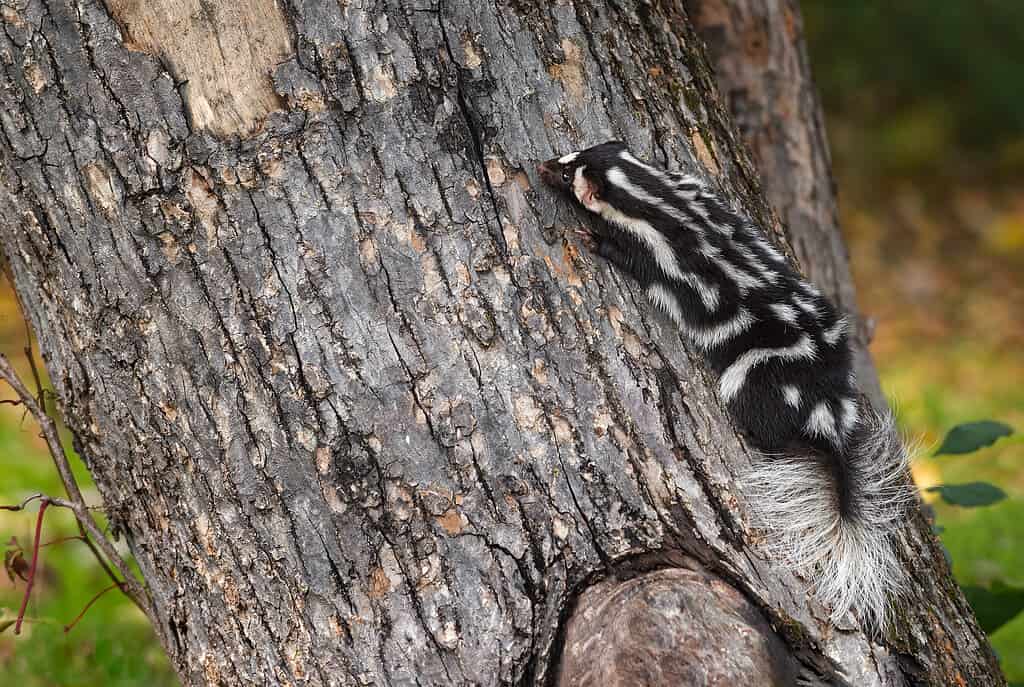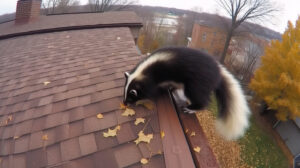Calm, mild-mannered, and curious, skunks are adorable little mammals often mistakenly thought of as rodents. The mammals, though, belong to the Mephitidae family. These critters are infamous for their sulfuric spray that smells awful and feels impossible to get out. But they use this as their self-defense against predators and things that go bump in the night. The primarily nocturnal animals hide out during the daytime, often in places we humans don’t want to find them because we might startle them and get sprayed. But where exactly do skunks live and hang out?
Let’s take a look.
Natural Habitat of Skunks

The adorable spotted skunks live in various places all over the United States. You’ll potentially find their nests under porches or in hollowed out trees.
©Holly Kuchera/Shutterstock.com
Naturally, skunks live in burrows and dens across North America. The specific type of skunk will determine its exact location.
- Striped skunks (Mephtis mephitis) — Throughout United States and Canada
- Hog-nosed skunks (Conepatus leucontus) — Colorado, central and south New Mexico, southern half of Texas, northern Mexico
- Spotted skunks (Spilogale putorius) — Throughout United States and northern Mexico
- Hooded skunks (Mephitis macroura)— limited to southwest New Mexico and west Texas
Skunks generally prefer letting other animals do the work for them, building and digging the burrows and dens for them. They will then overtake the abandoned dens after the previous owner vacates it. If needed, though, skunks will use their strong, sharp claws to dig their own burrows. They usually build their burrows with chambers, lined with grass, leaves, and hay. They tend to create at least four entrances to their dens for easy exiting.
Skunks may also nest in numerous other spots like open prairies, woodpiles, under brush, in hollow logs, under porches and other structures, and in culverts.
Where Do Skunks Live in Urban and Suburban Areas

Calm, tolerant, and curious creatures, skunks often make their way into urban and suburban areas. They prefer the wilds of their natural habitats, but as cities and towns are built up, their native lands are stripped of burrowing places and food. So, they move towards people. Since they are naturally curious, this doesn’t bother them as much as some more timid animals. They rarely travel more than 2 miles from their dens, though, except during mating season, meaning that in most cases they have a fairly small radius of terrain they’ll explore.
Skunks nest in locations where they’ll find food and shelter, with a few favorite urban and suburban spots in particular topping the list.
Brush Piles
Though they won’t stay here all the time, skunks do sometimes burrow into brush and leaf piles to spend the day resting away from sunlight and danger. They’ll find food down there, too, under all the leaves and natural debris. So, before you deal with a brush pile, you may want to carefully examine it for signs of fluffy black and white life beneath.
Abandoned Animal Burrows
Skunks love letting other critters do the work for them. In most cases, they prefer moving into abandoned burrows left behind by other animals rather than digging their own. So, if you spot an old burrow somewhere, it’s likely to become a skunk home at some point!
Under Porches, Sheds, Decks, and Other Outbuildings
Because of the warmth provided in areas inhabited by humans, skunks often create their dens beneath human-built structures. These structures tend to protect the burrows beneath as well as keep the soil warmer for easier digging.
Hollowed Out Logs and Trees

Skunks are excellent climbers so they may well climb old, dead trees, and build their nests within.
©Holly Kuchera/Shutterstock.com
Hollowed out logs provide skunks with the perfect den for resting and hiding from danger. They’ll also climb trees and use hollowed out dead trees as their dens, since they are excellent climbers and heights help provide a bit of extra protection. Often, these hollowed out spaces are abandoned homes of previous tenants. Skunks will occasionally hollow them out for themselves, though, if they can’t find an otherwise suitable den, particularly brooding mothers.
What Are Skunks Looking For When They Come Into Urban Areas?
Just like other animals, skunks are seeking two things when they “invade” human-inhabited areas. They need shelter and food. Likely, the burrow they had previously wasn’t working or it was destroyed. Or the skunk may have reached maturity and left its mother in search of its own den.
In wintertime, skunks frequently search out new dens because their old ones no longer allow them to dig and food sources have grown scarce. Your garbage may have attracted the animal with something tasty (like old produce) or your backyard had soft enough ground for digging. Often, skunks build their burrows under decks, porches, and sheds because the ground here is protected from the wind and sometimes may be warmer than other spots around.
When Do Skunks Actually Spray?

Skunks use their spray for defense, not simply because they want to “get” someone. They’re generally curious and friendly but they do, unfortunately, startle easily. This is how most folks wind up with the stink on them: startling these critters in the wild.
©Geoffrey Kuchera/Shutterstock.com
A lot of folks find skunks awful, semi-terrifying animals. But the reality is, these docile, adorable critters aren’t anything to be scared of. Their only defense really is their stink gland and the spray those offer. Technically, they can claw or bite, as well, but they’re generally too frightened to get that far. Instead, these timid but curious animals are most likely to spray when they’re in specific circumstances.
- If they feel threatened or fearful, they’ll instinctively turn tail and hose their predators down with the noxious liquid.
- Generally, this occurs when humans or pets startle them, not as a first line intent.
- Skunks have poor eyesight, so getting startled can be fairly common. They easily stumble into the paths of dogs and people when they’re out foraging.
- They’re particularly prone to scaring easily when they’ve just woken up from a long nap.
- Skunks will spray you if you approach their burrow unexpectedly.
- Some skunks actually like humans and will come investigate you if you sit very still. Be sure not to move to avoid that spray!
Thank you for reading! Have some feedback for us? Contact the AZ Animals editorial team.







